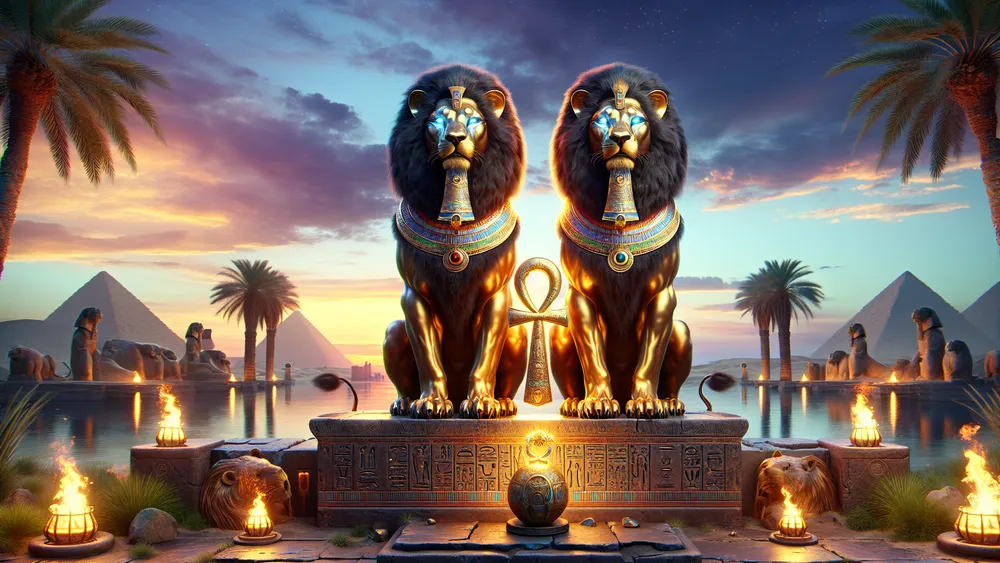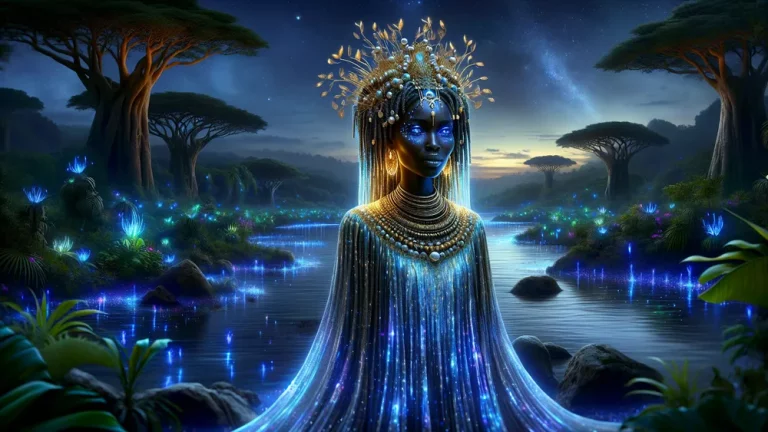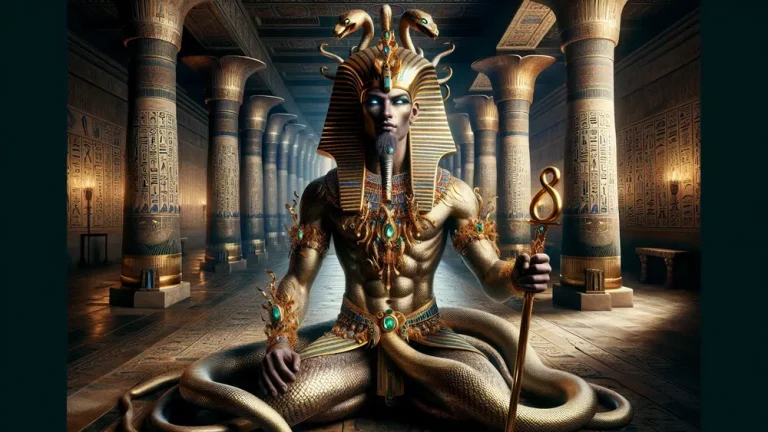Ruty: The Twin Lion Gods Of Egyptian Mythology
Hello to an in-depth look at Ruty, the twin lion gods of old Egyptian stories. Visualize two mighty lions, stationed at the entrances of old temples, showing both savagery and safety. Here, you will find out where these strong gods come from and their importance, named Ruty, who were very important in the religious and cultural scene of ancient Egypt.
Key Points:
- Ruty are twin lion gods in Egyptian mythology symbolizing duality and protection.
- They are crucial in Egyptian religious and cultural beliefs, linked to the sun god Ra.
- Ruty guard Ra during his nightly underworld trip, maintaining balance and order.
- Depicted in art and buildings, Ruty are often shown back-to-back as guardians.
- Ruty are part of burial texts like the Book of the Dead, guiding and protecting the dead.
- Similar twin lion themes exist in Mesopotamian, Greek, and Roman cultures.
- Ruty’s role aligns with other lion deities like Sekhmet and Bastet, representing strength and protection.
We will look into where their stories began, what they symbolize, and how they appear in art forms and building styles. We will also look at how they connect to other main gods like Ra, the main sun god, and how they show up in burial writings and rituals.
By looking at Ruty with other lion gods like Sekhmet and Bastet, and seeing how twin lion themes show up in other cultures, we want to give a clear view of these interesting gods. No matter if you are new to these stories or very familiar, this trip into the world of Ruty hopes to be very educational and interesting.
Ruty: Overview and Key Facts
| Main Point | Details |
|---|---|
| Name | Ruty (also called the Twin Lions) |
| Type | Paired lion gods |
| Meaning | Two things, safety, balance |
| Stories From | Come from old Egyptian mythology, related to Ra, the sun god |
| Importance in Culture | Crucial to religion, art, old buildings in Egypt |
| Shown in Art Forms | Usually seen as two lions, often beside major gods or symbols |
| Linked Gods | Ra (sun god), Sekhmet, Bastet |
| Ancient Texts and Items | Talked about in many old texts, shown in many items |
| Religious Role | Guardians of Ra at night in the underworld |
| In Burial Texts | Mentioned in texts like Book of the Dead, guiding and protecting the dead |
| Other Cultures | Same twin lion ideas in Mesopotamian, Greek, and Roman stories |
Getting to Know Ruty in Egyptian Mythology
To truly grasp the importance of Ruty, the twin lion gods, one must dig deeper into their ancient tales and the jobs they had in old Egyptian life.
The Roots and Importance of Ruty
The myth stories about Ruty, two lion gods, come from old Egyptian tales. These gods show up often as two strong lions, meaning two sides and balance in nature. Just like the sun goes up and down, making night and day even, Ruty shows the balance between opposite things.
Ruty is linked to the sun god Ra, acting as guards where the sun shows up and goes away. Their link to Ra shows they help keep the world’s balance and order.
In ancient Egyptian life, Ruty was very important. They were seen not just as Ra’s protectors but also as signs of safety and balance among people. Temples and big buildings for Ruty were common, and their pictures were often used to ask for their protection. The presence of Ruty in many religious writings and objects shows their importance. Some key texts and objects include:
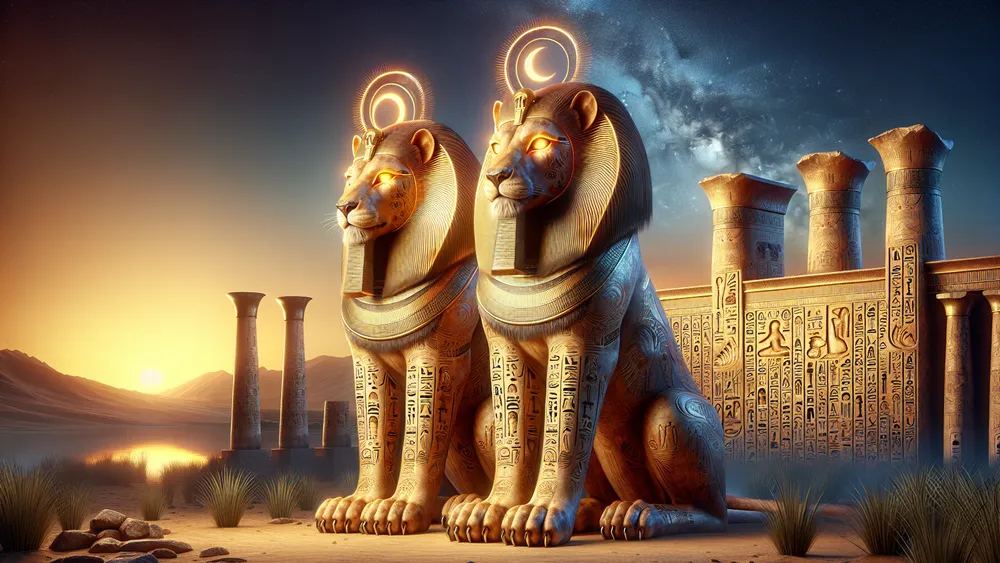
- Book of the Dead
- Pyramid Texts
- Coffin Texts
- Various temple writings and carvings
These sources give us important details about how the old Egyptians saw and honored Ruty, showing their role in both the world of gods and humans.
Ruty, the lion gods, symbolize balance in nature and were highly honored in ancient Egyptian culture, as seen through various religious texts and objects.
What the Twin Lions Stand For
The twin lions, Ruty, mean a lot in old Egyptian tales. As representations of duality, they show the balance between opposites like day and night, life and death, and order and chaos. Their job as guards of the horizon involves protecting Ra, the sun god, on his nightly trip through the underworld, making sure he rises back each morning.
They also protect people and towns. In various religious texts and rituals, shown as forces that keep things steady, the idea of balance is represented.
Other lion-like gods and heroes share traits of strength and protection:
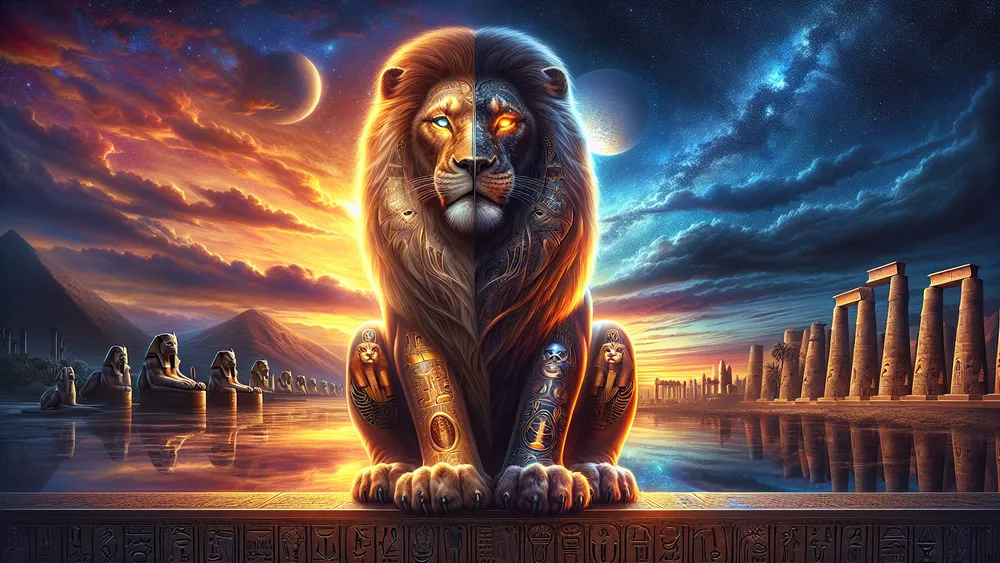
- Sekhmet: The lioness goddess of war and healing
- Bastet: Cat or lioness goddess of home, fertility, and childbirth
- Nergal: The Mesopotamian war and plague god, often with lion features
- Heracles: Greek hero, known for his strength, wore lion’s skin as armor
These characters show how lions symbolize strength, protection, and balance in different stories and cultures.
Ruty in Egyptian Art and Buildings
Ruty, the twin lion gods, show up a lot in Egyptian art and buildings. They are often shown as two lions sitting back-to-back, which means they guard the horizon where the sun goes up and down. Like those statues of lions in front of buildings, their role is protection and watching over.
Often seen next to important gods or symbols, their images on temple walls, tombs, and different objects show their importance in both holy and regular settings.

Temples and big monuments highlight Ruty’s importance. An example is the Temple of Ruty at Leontopolis, which got its name from the lion gods. This temple was a big religious place where people did rituals and ceremonies to honor Ruty and ask for their protection. Other important places include the Karnak Temple Complex, where Ruty shows up in various carvings and writings. These spots were for worship and cultural hubs, emphasizing Ruty’s role in keeping cosmic and societal balance. Below you will find a table comparing different artistic representations of Ruty across different times:
| Period | Artistic Representation | Key Features |
|---|---|---|
| Old Kingdom | Reliefs in tombs and temples | Lions sitting back-to-back, with gods next to them |
| Middle Kingdom | Statues and amulets | Detailed carvings, often with sun disks |
| New Kingdom | Temple wall carvings and writings | More fancy and dynamic poses |
| Late Period | Funerary writings and temple decor | Mixed with other gods, more stylized |
The table shows how Ruty’s pictures changed over time, reflecting shifts in art styles and religious methods.
The Part Ruty Plays in Egyptian Religion
To truly understand the place of Ruty in old Egyptian religion, it is important to look at their ties with other gods and their spot in various religious writings and rituals.
Ruty and the Sun God Ra
The link between Ruty and Ra, the sun god, is very important in old Egyptian stories. Ruty, the twin lion gods, are often shown protecting Ra, making sure he gets through the underworld safely each night. They are like bodyguards for a big official, keeping Ra safe from dangers in the underworld.
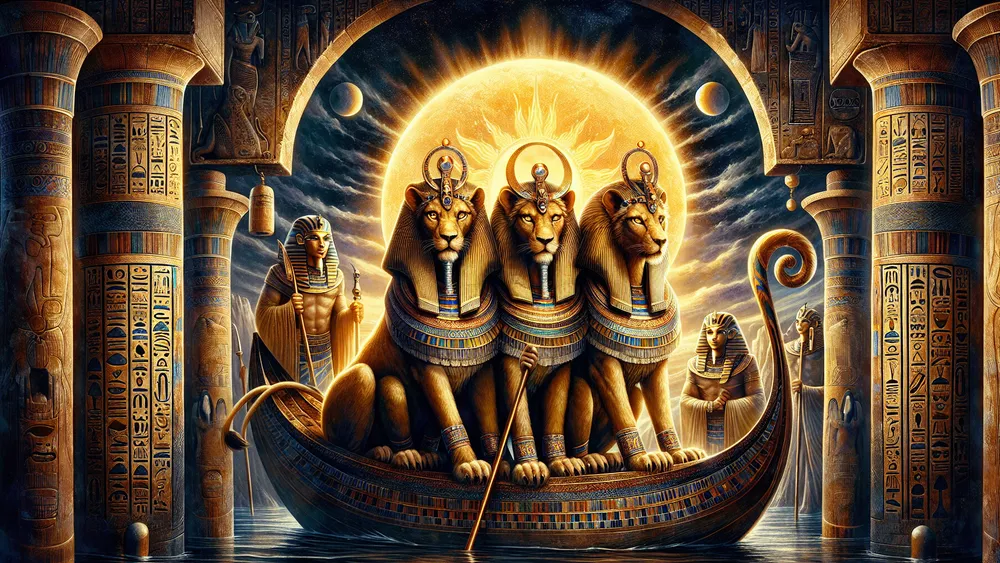
This role is very important because Ra’s trip through the underworld is needed for renewing the sun and life going on. Without Ruty’s watchfulness, Ra’s trip could be at risk, messing up the balance of everything.
Ruty’s job of guarding Ra on his nightly trip is shown in different stories and myths. In these tales, Ra goes through the underworld in a solar boat, facing many challenges and enemies. Ruty stands watch at the horizon, where Ra goes in and out of the underworld, making sure he isn’t hurt by bad forces. This journey isn’t just a trip, but a symbol of the cycle of life, death, and rebirth. The following myths and stories show Ruty’s key role:
- The Book of the Dead: Talks about Ra’s trip through the underworld and how Ruty protects him.
- The Amduat: An old Egyptian funeral text that tells about Ra’s twelve-hour journey through the underworld.
- The Liturgies of Ra: Ritual texts with calls to Ruty to protect Ra during his night trip.
These stories show how essential Ruty is in keeping the order of the universe and ensuring the sun comes back every day.
Ruty in Funerary Texts and Rituals
Ruty, the twin lion gods, have an important spot in old Egyptian funeral texts and rituals. These texts often show Ruty as guardians and guides for the dead, making sure they get through the dangerous land of the underworld safely. In the same way a guide leads someone through a dark, strange place, Ruty helps the dead with the challenges they meet after death.
Their presence in these texts shows their role in keeping cosmic order and protecting the souls of the dead. Images of Ruty show up in various funeral items like tomb paintings, amulets, and sarcophagi, all pointing out their importance in the trip to the afterlife. The part Ruty plays in leading and guarding the dead is stressed in texts like the Book of the Dead.
This old Egyptian funerary book has spells and chants meant to help the dead overcome obstacles and get to the afterlife. Ruty is often called in these spells for protection and help. For example, one spell asks Ruty to guard the dead from evil forces and make sure they pass through the underworld safely.
Other important texts that mention Ruty are the Coffin Texts and the Pyramid Texts, which also have invocations and pictures of the twin lions. These texts show Ruty’s crucial role in old Egyptian funeral practices, stressing their importance in ensuring the soul’s safe and successful trip to the afterlife.
Comparing Ruty with Other Lion Gods
To get a clearer picture of Ruty’s special qualities, it helps to look at them next to other lion deities in Egyptian myths and beyond.
Ruty vs. Sekhmet and Bastet
Ruty, Sekhmet, and Bastet are all lion gods in Egyptian mythology, but they do different things and have unique features. Ruty, the twin lion gods, are mainly known for their protective and guiding roles, especially with the sun god Ra and the dead in the afterlife. But Sekhmet, usually shown as a lioness, is the goddess of war and healing.
She shows the fierce and destructive power of the sun, able to both cause and cure diseases. Bastet, another lioness god, stands for a more caring aspect. She is the goddess of home, fertility, and childbirth, often shown as a lioness or a house cat.
While Ruty’s role is more about protection and guidance, Sekhmet and Bastet have wider areas that include both destructive and caring elements. Although they are different, there are some similar roles among these gods. For example, both Ruty and Sekhmet are linked to protection, though Sekhmet’s protection is often more aggressive and warlike, while Ruty’s is more about guarding and guiding. Bastet, however, shares a protective role in the home and family context.
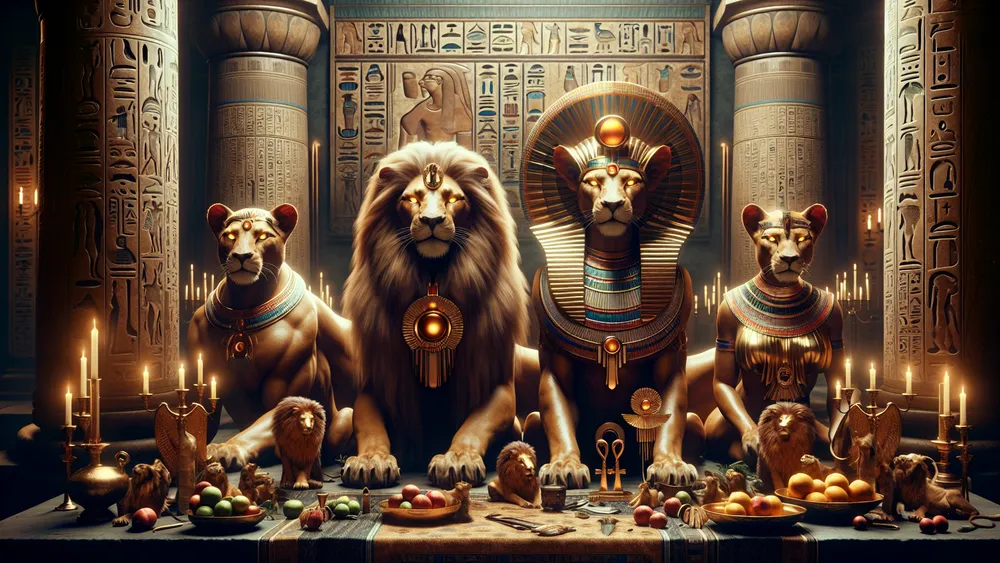
This difference can be seen like different types of guardians: Ruty are the watchful guards, Sekhmet is the fierce warrior, and Bastet is the caring caretaker. Each god’s unique features and roles show the different ways the ancient Egyptians thought about protection, power, and care in their gods.
Ruty is known for protection and guidance, Sekhmet for war and healing, and Bastet for a caring aspect, each representing different types of guardians in Egyptian mythology.
Twin Lions in Other Cultures
The idea of twin lions is not just in Egyptian stories; it shows up in many old cultures, each with its own meaning. In Mesopotamian stories, for instance, twin lions are often linked to the goddess Ishtar, showing her power and protective side. These lions are shown as fierce guardians, much like Ruty in Egyptian myths.
Similarly, in Greek legends, the Nemean Lion, though not a twin, shares the traits of strength and being unbeaten. The Greeks also had the idea of twin lions guarding sacred places, such as the well-known Lion Gate at Mycenae.
These examples show how the picture of lions as strong protectors goes beyond cultural lines, serving as a common sign of strength and guardianship. But, there are big differences in how twin lions are seen and worshipped across cultures.
In Roman stories, for example, lions are often linked to the god Bacchus (Dionysus in Greek myths), where they symbolize both the wild, untamed parts of nature and the protective forces that guard holy spaces. This duality is somewhat different from the more purely protective role of Ruty in Egyptian stories.
Also, while the Mesopotamian twin lions are closely tied to a specific goddess like Ishtar, the Greek and Roman views often place lions in a more general protective role, guarding temples and city gates. These differences show the varied ways in which ancient cultures used the strong image of twin lions to reflect their unique values and beliefs.
Pantheon of All Egyptian Mythology Gods
The Egyptian group of gods is a big and detailed collection of gods, each with their own unique features, stories, and roles within the myths. From well-known gods like Ra, Osiris, and Isis to lesser-known ones, the group shows the complexity and richness of old Egyptian religion.
For people who want to look at the full list of all Egyptian gods, you can check a thorough list of all the Egyptian gods that jumps into the details of each god and what they mean. This resource gives a deep look at the divine figures that shaped the spiritual world of ancient Egypt.
FAQs
1. Who are the twin lion gods in Egyptian mythology?
The twin lion gods in Egyptian mythology, known as Ruty, symbolize duality, protection, and balance.
2. How are Ruty depicted in ancient Egyptian art?
Ruty are depicted in ancient Egyptian art as twin lions often shown seated back-to-back, symbolizing duality and protection.
3. What is the relationship between Ruty and Ra?
The relationship between Ruty and Ra involves Ruty protecting Ra during his nightly journey through the underworld.
4. Are there other cultures with twin lion deities similar to Ruty?
Yes, other cultures with twin lion deities similar to Ruty include Mesopotamian, Greek, and Roman mythologies, where twin lions often symbolize protection and guardianship.

